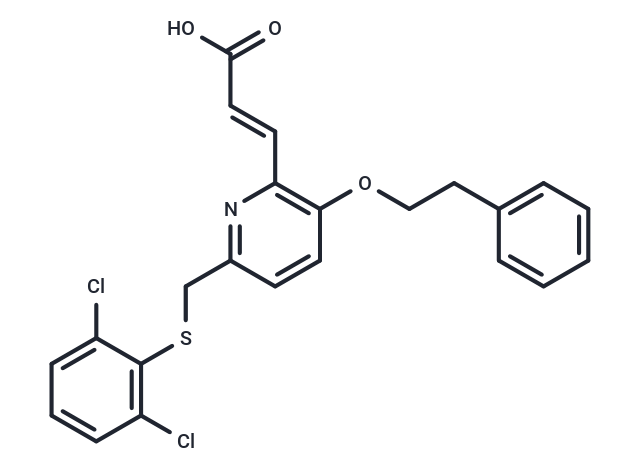Shopping Cart
- Remove All
 Your shopping cart is currently empty
Your shopping cart is currently empty

Ticolubant is orally active leukotriene B4 antagonist with high affinity for the human neutrophil LTB4 receptor (Ki = 0.78 nM), blocks LTB4-induced Ca2+ migration with an IC50 of 6.6 ± 1.5 nM, and shows topical anti-inflammatory activity in a mouse model of skin inflammation.

| Pack Size | Price | Availability | Quantity |
|---|---|---|---|
| 1 mg | $126 | In Stock | |
| 5 mg | $318 | In Stock | |
| 10 mg | $460 | In Stock | |
| 25 mg | $708 | In Stock |
| Description | Ticolubant is orally active leukotriene B4 antagonist with high affinity for the human neutrophil LTB4 receptor (Ki = 0.78 nM), blocks LTB4-induced Ca2+ migration with an IC50 of 6.6 ± 1.5 nM, and shows topical anti-inflammatory activity in a mouse model of skin inflammation. |
| Molecular Weight | 460.37 |
| Formula | C23H19Cl2NO3S |
| Cas No. | 154413-61-3 |
| Smiles | C(=C/C(O)=O)\C1=C(OCCC2=CC=CC=C2)C=CC(CSC3=C(Cl)C=CC=C3Cl)=N1 |
| Relative Density. | 1.31g/cm3 |
| Storage | Powder: -20°C for 3 years | In solvent: -80°C for 1 year | Shipping with blue ice. | |||||||||||||||||||||||||||||||||||
| Solubility Information | DMSO: 50 mg/mL (108.61 mM) | |||||||||||||||||||||||||||||||||||
Solution Preparation Table | ||||||||||||||||||||||||||||||||||||
DMSO
| ||||||||||||||||||||||||||||||||||||

Copyright © 2015-2024 TargetMol Chemicals Inc. All Rights Reserved.